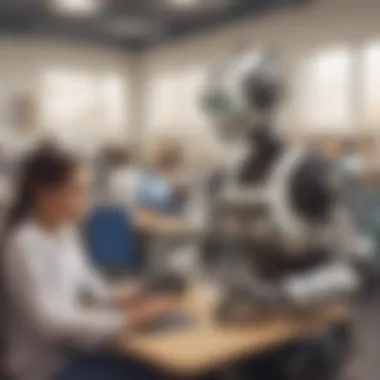Understanding STEAM Projects: A Comprehensive Exploration


Intro
In recent years, STEAM projects have gained prominence in educational contexts. The STEAM framework integrates Science, Technology, Engineering, Arts, and Mathematics, promoting a well-rounded approach to learning. This article aims to provide a comprehensive exploration of STEAM projects, elucidating their significance and practical application in various educational settings.
Through diverse methodologies, educators and parents can leverage STEAM projects to foster critical thinking and creativity among children. This guide is tailored to deliver insightful perspectives on implementing and maximizing the benefits of STEAM initiatives.
Interactive Learning Games
Educational games serve as a vital tool in the STEAM framework, facilitating engaging learning experiences for children. These games allow students to explore complex concepts in a fun and stimulating environment.
Popular Games
Several learning games stand out in fostering a steamlined learning experience. Noteworthy titles include
- Minecraft: Education Edition
- Kahoot!
- Osmo Coding
Each game offers unique educational benefits, encouraging collaboration and creativity.
Description of Top Educational Games
Minecraft: Education Edition encourages players to think like architects and engineers while solving problems in a virtual world.
Kahoot! engages learners through interactive quizzes, allowing for real-time feedback and competition.
Osmo Coding introduces coding principles by blending traditional play with digital learning, making coding tangible and accessible.
Benefits of Playing Educational Games for Kids' Cognitive Development
Engaging with educational games enhances various cognitive skills:
- Problem-solving: Games present challenges that require strategic thinking.
- Collaboration: Many games promote teamwork, teaching kids to work together.
- Creativity: Open-ended gameplay allows for artistic expression and creativity.
"Educational games bridge the gap between fun and learning, making them effective tools for cognitive development."
Game Reviews
Minecraft: Education Edition has received acclaim for its creativity and immersive learning environment.
Kahoot! is praised for its ability to create engaging classroom interactions and accelerate revision processes.
Osmo Coding stands out by turning coding into a playful experience for young learners, blending digital and physical interaction seamlessly.
Comparison of Gameplay and Learning Outcomes
Each of these games contributes distinctively to different learning outcomes. Analyzing their designs reveals how gameplay mechanics align with educational goals. For example, Minecraft can develop spatial awareness and critical thinking, while Kahoot! provides instant feedback through quizzes, enhancing knowledge retention.
Educational Topics
An essential aspect of STEAM is the interdisciplinary approach to education. This incorporates various subjects like:
- Math
- Science
- Languages
- Arts
Importance of Interdisciplinary Learning for Holistic Development
Integrating multiple disciplines not only enhances knowledge in particular subjects but also fosters critical thinking and creativity. Each subject supports others; for example, art can enhance science projects through creative representation.
Tips and Tricks
Here are some practical strategies for parents and educators to make learning engaging:
- Incorporate Hands-On Learning: Encourage participation in activities that require physical interaction with materials.
- Use Technology Wisely: Integrate digital tools that complement hands-on activities.
- Facilitate Discussions: Allow children to voice their thoughts on projects, fostering communication skills.
These tips can enhance children’s learning journeys and instill a lifelong passion for knowledge.


Creative DIY Projects
Hands-on projects are an excellent way to explore STEAM concepts creatively.
Step-by-Step Guides
Engaging in DIY projects encourages children to think innovatively. Consider projects like constructing a simple circuit using batteries and bulbs or creating art with recycled materials.
Benefits of Hands-On Activities for Children's Cognitive and Motor Skills
Hands-on activities are beneficial for children’s cognitive and motor skills development. They promote fine motor skills through manipulation of objects while providing real-world applications for theoretical concepts.
Craft Ideas
A collection of craft ideas that require minimal resources can inspire creativity. Projects can range from making paper mache models to designing simple robotics with household items.
Importance of Artistic Expression in Children's Development
Creative expression is fundamental for childhood development. It allows children to explore emotions and thoughts. Moreover, artistic activities can improve problem-solving and critical thinking skills, essential in STEAM disciplines.
Defining STEAM Projects
Understanding the concept of STEAM projects is crucial for grasping their role in modern education. STEAM stands for Science, Technology, Engineering, Art, and Mathematics. Each component plays a vital part in developing a well-rounded educational approach that encourages students to think critically and creatively. STEAM projects foster hands-on learning experiences, which can enhance engagement and retention of knowledge.
In this context, defining STEAM projects involves looking closely at both their structure and their purpose. These projects involve integrating multiple disciplines, which can lead to deeper comprehension and appreciation for each subject. Importantly, they often address real-world problems, making the learning relevant and practical for students.
By emphasizing collaboration and interdisciplinary approaches, STEAM projects not only enrich the curriculum but also appeal to diverse learning styles. Engaging children in STEAM projects prepares them for future challenges in a rapidly changing world. Thus, it is essential to understand what exactly encompasses STEAM projects to effectively implement and advocate for them in educational settings.
What Does STEAM Stand For?
The term STEAM is an acronym representing five distinct yet interconnected fields: Science, Technology, Engineering, Art, and Mathematics. Each of these elements contributes uniquely to a holistic understanding of the world around us. Science provides methods to observe, experiment, and draw conclusions about our environment. Technology includes tools and software that enhance learning and facilitate problem-solving. Engineering integrates design and functionality, allowing for the practical application of concepts. Art encourages creativity and expression, vital for innovative thinking. Lastly, Mathematics offers quantitative analysis and logical reasoning, foundational skills for interpreting data.
The Historical Context of STEAM
The evolution of STEAM can be traced back to educational movements that recognized the interconnectedness of various disciplines. This shift began gaining traction in the late 20th century, emerging as a response to the growing demand for a workforce skilled in multiple areas. The blending of these domains allows students to tackle complex, interdisciplinary problems that reflect real-life scenarios. In recent years, the incorporation of Art into the traditional STEM framework has gained momentum, which is seen as a critical enhancement. This addition recognizes the importance of creativity and innovative thinking alongside technical skills.
Difference Between STEM and STEAM
The distinction between STEM and STEAM lies primarily in the inclusion of Art. STEM focuses solely on Science, Technology, Engineering, and Mathematics, emphasizing technical proficiency and analytical skills. In contrast, STEAM incorporates artistic elements, promoting a more holistic learning experience. The integration of art helps students develop creative thinking skills and encourages them to approach problems from different perspectives.
Research indicates that engaging in arts-based activities enhances cognitive abilities, which is beneficial in all STEAM fields. This sleight of hand makes STEAM not just an educational framework, but a philosophy advocating for innovation through collaborative and creative methods. Understanding this difference is essential for educators aiming to cultivate well-rounded thinkers.
Components of STEAM Projects
Understanding the components of STEAM projects is crucial for recognizing how each discipline contributes to a holistic learning experience. By integrating Science, Technology, Engineering, Art, and Mathematics, these projects foster a well-rounded approach to education. This synergy not only enhances critical thinking but also prepares children for real-world challenges. Each element plays a significant role in stimulating curiosity and innovation among students.
Science in STEAM
Science provides the foundational knowledge necessary for understanding natural phenomena. It encourages inquiry and exploration, which are essential for developing analytical skills. By engaging with scientific concepts, children learn to ask questions and seek solutions, cultivating a mindset geared towards problem-solving. Experiments and hands-on activities invite students to observe outcomes, analyze data, and draw conclusions—skills that have broad applications beyond the classroom.
Technology's Role in STEAM Projects
Technology has transformed how we approach education. In STEAM projects, it serves as both a tool and a subject of study. Students interact with various technological tools, such as computers, software, and robotics, allowing them to comprehend complex systems. This experience not only boosts digital literacy but encourages learners to innovate. Today’s children are future creators, and understanding technology's role is vital in a world defined by rapid technological advancements.
The Importance of Engineering
Engineering is often described as the practical application of scientific principles. It focuses on designing solutions to real-world problems. In the STEAM framework, engineering encourages children to think critically about design and functionality. Young learners are tasked with creating tangible products, which enhances their understanding of material properties, structural integrity, and design processes. This hands-on experience bridges the gap between theory and practice, reinforcing the importance of engineering in daily life.
Art as a Catalyst for Creativity
Art is often misunderstood as simply a creative outlet. However, in the context of STEAM, it plays a pivotal role in fostering creativity and expression. Through artistic endeavors, children can visualize concepts, express emotions, and think outside the box. Engaging with art promotes diverse ways of thinking and enhances motivation. Incorporating art into STEAM projects enables learners to approach problems with a unique perspective, facilitating innovative thinking and engagement.
Mathematics in Real-World Applications


Mathematics is an essential discipline within STEAM, providing the quantitative tools necessary for analysis. It allows students to engage with data, understand patterns, and make informed decisions. Applying math to real-world situations demonstrates its relevance and importance. By integrating math into STEAM projects, educators can help students appreciate its role in everyday life and professional settings. This aids in developing a generation that is proficient in numerical reasoning.
"The integration of these components empowers learners to connect their knowledge across multiple domains, enriching their educational experiences."
The Importance of STEAM Projects for Children
In today's rapidly changing world, STEAM projects are essential for children's educational growth. They create avenues for children to engage with critical concepts and develop essential skills. These projects encompass multiple disciplines and offer a holistic approach to education. This section will explore the specific benefits that STEAM projects provide to children, enriching their learning experience in various ways.
Fostering Critical Thinking Skills
Critical thinking skills are essential in understanding complex issues and making informed decisions. STEAM projects engage children in activities that require analysis, evaluation, and synthesis of information. For instance, a simple project on building a bridge can prompt questions about materials, structural stability, and weight distribution. As children navigate through these processes, they learn to approach problems methodically. Ultimately, such critical thinking exercises prepare them for real-world situations where problem-solving is necessary.
Promoting Collaboration and Teamwork
Collaboration is a key component of successful STEAM projects. When children work together, they learn to communicate ideas and negotiate different viewpoints. This interaction fosters teamwork, an invaluable skill in both education and future careers. In group settings, each child can bring their unique perspective to the table. For example, a science experiment involving multiple roles allows each child to contribute in a meaningful way. This collaborative experience helps create a sense of belonging among peers and teaches children how to appreciate others' strengths and weaknesses.
Encouraging Creativity and Innovation
Creativity is not limited to the arts; it is a vital component of the STEAM framework. Engaging with STEAM allows children to think outside the box. For instance, a project could involve designing a sustainable garden. Children must think creatively about plant selection, layout, and irrigation methods. This process encourages innovative thinking when they face challenges in execution. As they consider different solutions, they enhance their ability to approach problems with an open mind.
Enhancing Problem-Solving Abilities
The practical aspect of STEAM projects significantly enhances children's problem-solving abilities. When faced with challenges during a project, children learn to identify obstacles and devise strategies to overcome them. For example, if a prototype fails to operate as intended, they will need to reassess their approach and experiment with alternatives. This iterative process is crucial in fostering resilience. Instead of fearing failure, children learn that setbacks are an opportunity for growth and learning, a lesson that will benefit them throughout their lives.
"STEAM education emphasizes hands-on learning experiences, where trial and error can lead to successful innovation."
Implementing STEAM Projects in Educational Settings
Implementing STEAM projects in educational settings has become essential in modern teaching methodologies. It encompasses the integration of science, technology, engineering, arts, and mathematics into cohesive learning experiences. This approach aims to bridge the gap between theoretical knowledge and practical application, making learning more relevant and engaging for students. By incorporating STEAM projects into the curriculum, educators can facilitate a deeper understanding of complex concepts while nurturing essential skills needed for the future.
Designing Effective STEAM Activities
In designing effective STEAM activities, educators must consider various factors to ensure that students can engage meaningfully. Activities should be project-based, involving hands-on experiences that challenge students to think critically and creatively. For instance, a project might involve designing a simple bridge using everyday materials, which includes concepts from engineering and mathematics.
Key points to consider when designing activities include:
- Clear Objectives: Set specific learning goals that align with both STEAM components and broader curricular standards.
- Diversity of Skills: Encourage teamwork and the use of various skills, allowing students to contribute their strengths to the overall project.
- Reflection: Include time for students to reflect on their learning and the process of completing the project.
"The purpose of education is to replace an empty mind with an open one." – Malcolm Forbes.
Integrating STEAM into Existing Curriculums
Integrating STEAM into existing curriculums can present challenges, yet it is crucial for fostering a well-rounded education. Educators should look for natural connections within the current curriculum to embed STEAM principles. For example, in a literature lesson, students could analyze narratives that incorporate scientific principles or engineering projects featured in the story.
Some effective strategies for integration are:
- Interdisciplinary Projects: Create units that draw from multiple subject areas, emphasizing how concepts overlap in the real world.
- Flexible Scheduling: Adjust timetables to allocate time for in-depth STEAM projects that require extended collaboration and exploration.
- Professional Development: Provide training for teachers to identify opportunities for STEAM integration in their subject areas.
Utilizing Technology and Resources
Technology plays a significant role in enriching the STEAM learning experience. It can enhance both student engagement and understanding by providing access to innovative tools and resources.
To effectively utilize technology, consider the following:
- Digital Tools: Incorporate software applications for design, simulations, or coding. Tools like Tinkercad or Scratch can foster creativity and technical skills.
- Online Collaboration: Encourage students to collaborate with peers online, facilitating teamwork and communication skills.
- Resource Accessibility: Ensure that students have access to necessary materials, whether they are physical supplies or digital resources.
With thoughtful planning and implementation, STEAM projects can greatly enrich the educational experience. They not only prepare students for future challenges but also promote a culture of curiosity and innovation.
Challenges of Conducting STEAM Projects
Conducting STEAM projects can present various challenges that impact their overall execution and success. Recognizing these difficulties is crucial for educators, caregivers, and administrators who aim to implement these innovative educational frameworks. Addressing these challenges ensures that the potential benefits of STEAM education can be fully realized.
Resource Limitations and Accessibility


One significant challenge in STEAM projects is resource limitations. Schools often operate on tight budgets, making it difficult to acquire the necessary materials, tools, and technology. For instance, obtaining quality equipment for science experiments or art supplies can strain financial resources. Additionally, access to technology is essential for integrating STEAM effectively. Not all students have the same access to computers or high-speed internet, which can create disparities in learning opportunities. Thus, educators must find creative ways to source materials. This may include seeking donations, using recycled materials, or forming partnerships with local businesses.
Balancing Curriculum Requirements
Another challenge is balancing STEAM projects with existing curriculum requirements. Teachers face pressure to meet specific academic standards and tests. Integrating hands-on STEAM projects may seem time-consuming and may conflict with traditional teaching methods. However, aligning STEAM activities with standard objectives and learning goals can help. For example, integrating math and science lessons into practical projects can satisfy curriculum needs while enriching the learning experience. Teachers need support from school administrators to navigate this balance effectively, ensuring that STEAM projects remain a priority.
Teacher Preparedness and Training
Teacher preparedness is vital for the successful implementation of STEAM projects. Many educators may not feel confident in their abilities to teach integrated subjects like engineering or technology. Professional development and training are essential to equip teachers with the skills and knowledge they need. Workshops, online courses, or mentoring from experienced educators can enhance their capacity to manage STEAM initiatives. By investing in teacher training, schools can foster a supportive environment where teachers feel competent and excited about implementing STEAM projects.
"Success in STEAM education relies not only on resources but also on the preparedness of those guiding young minds through these integrated disciplines."
Best Practices for Educators and Caregivers
Incorporating STEAM projects into education requires thoughtful approaches that enhance learning experiences. Understanding and applying best practices plays a crucial role in achieving desired outcomes. These strategies not only improve children's engagement but also foster a supportive environment for exploration and teamwork. Educators and caregivers must emphasize methods that encourage active participation and critical thinking. By doing so, they can help children grasp complex concepts in science, technology, engineering, arts, and mathematics.
Encouraging Experimentation and Exploration
Encouraging children to experiment and explore is vital in STEAM education. This involves letting them take the lead in their learning journey. One effective way to foster experimentation is by providing varied resources and materials. For example, educators can use simple tools and recycled items to create engaging projects. This not only stimulates creativity but also teaches children to think resourcefully. Furthermore, allowing open-ended prompts can lead to imaginative solutions.
To encourage exploration, adults should:
- Ask open-ended questions that require thoughtful responses.
- Facilitate discussions about different approaches to problem-solving.
- Create a safe space for mistakes, emphasizing that errors are part of the learning process.
These strategies help children understand that curiosity and innovation go hand-in-hand.
Reflecting on Educational Outcomes
Reflection is a key component of the learning process. Educators and caregivers should regularly assess the impact of STEAM projects on children's understanding and skills. This can be achieved through various methods, including discussions, surveys, or journals. By gathering insights from children, adults can adapt their approaches to better meet students' needs.
Reviewing educational outcomes allows for:
- Identifying strengths and weaknesses in current practices.
- Adjusting lesson plans to suit diverse learning styles.
- Celebrating successes and recognizing children's achievements.
Such reflective practices not only benefit individual learners but can also influence broader teaching methods.
Creating an Inclusive Learning Environment
An inclusive learning environment is essential for effective STEAM education. Educators and caregivers should recognize the diverse backgrounds, skills, and interests of each child. Strategies to promote inclusivity include:
- Incorporating culturally relevant materials that resonate with all students.
- Offering varied roles in group projects, allowing everyone to participate according to their strengths.
- Valuing contributions from each child, ensuring their voices are heard.
Creating an inclusive space helps build a sense of community. When children feel respected and valued, they are more likely to engage deeply with STEAM projects. An inclusive environment not only enhances learning outcomes but also prepares students for collaboration in diverse settings.
"Inclusivity in learning is not just a philosophy; it is a practice that enriches the educational experience for all."
These best practices provide a framework for educators and caregivers aiming to integrate STEAM effectively into their teaching. By fostering experimentation, reflecting on outcomes, and creating an inclusive atmosphere, adults can significantly enhance the educational journey of children.
Future Directions for STEAM Education
In an increasingly complex and interconnected world, the future of STEAM education is pivotal. Understanding the evolution of STEAM projects can help educators, parents, and policymakers recognize their potential to enhance educational outcomes. As technology advances and society shifts, STEAM initiatives must adapt to remain relevant and impactful.
Emerging Trends in STEAM Initiatives
New trends continuously shape the landscape of STEAM education. Among the most significant is the rise of project-based learning. This method encourages students to engage in real-world problems, making the learning experience more relevant. Learning through projects not only enhances knowledge retention but also boosts student engagement. Another trend worth noting is the integration of artificial intelligence and machine learning in educational tools. These technologies facilitate personalized learning experiences, helping to cater to individual student needs.
Further, there is a growing emphasis on sustainability and environmental education within STEAM projects. Educators are focusing on creating awareness about ecological issues and promoting solutions through design and innovation. Such an approach not only educates but also empowers students to take action regarding climate change and environmental challenges.
Cross-Disciplinary Collaboration
Collaboration across disciplines is essential in STEAM education. When students work with peers from different fields, they develop a more holistic approach to problem-solving. This collaboration often leads to enhanced creativity and innovative outcomes. For example, combining arts with technology can foster a new generation of creators capable of designing user-friendly software while considering aesthetic elements.
Schools should promote partnerships between STEM educators and art instructors. These relationships can produce more compelling lessons that realize the synergy between these subjects. Engaging guest speakers from various industries, such as engineers and artists, can provide students with diverse perspectives and insights into cross-disciplinary applications.
Advocating for Systemic Change in Education
Lastly, to elevate STEAM initiatives, advocacy for systemic change is crucial. This involves urging educational institutions and policymakers to prioritize STEAM programs in funding and curriculum decisions. By investing in these initiatives, schools can cultivate environments conducive to innovation and learning.
Moreover, addressing inequalities in educational resources can lead to more inclusive STEAM experiences. Schools in underprivileged areas often lack the tools necessary for effective STEAM learning. Advocating for resource allocation towards these schools is vital to ensure all students can benefit from STEAM education.
"The integration of STEAM into the educational system not only prepares students for future careers but also nurtures critical thinking, creativity, and collaboration skills."















